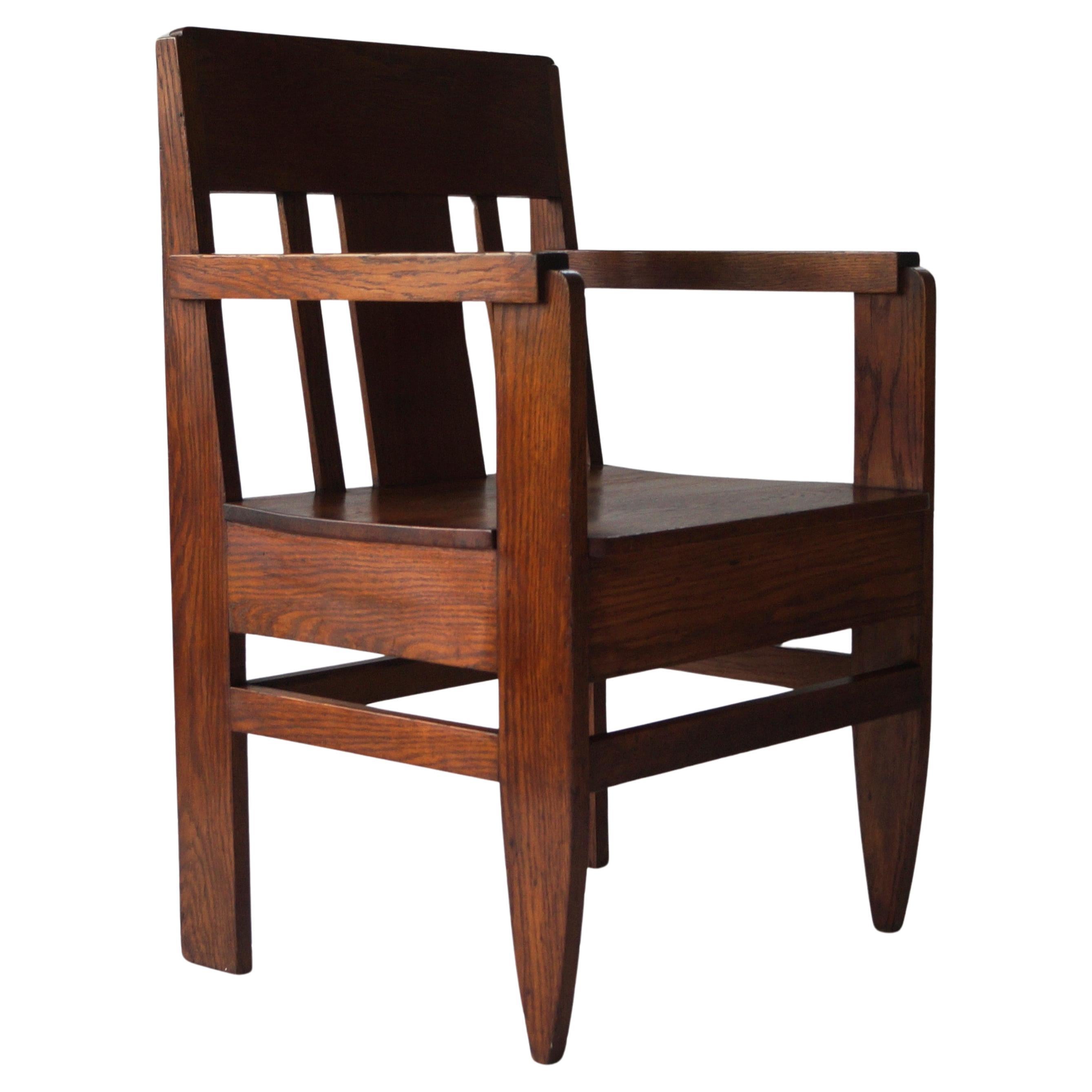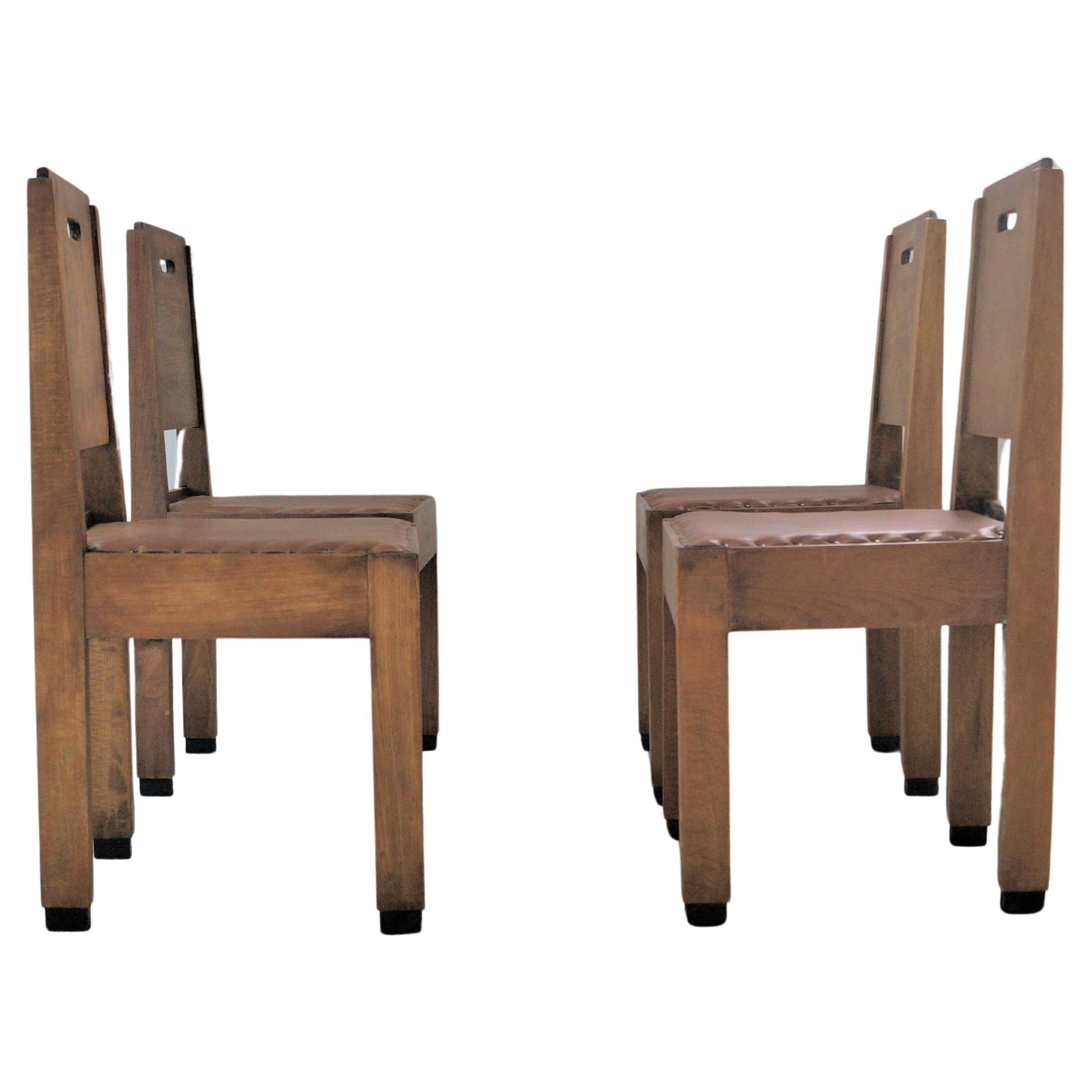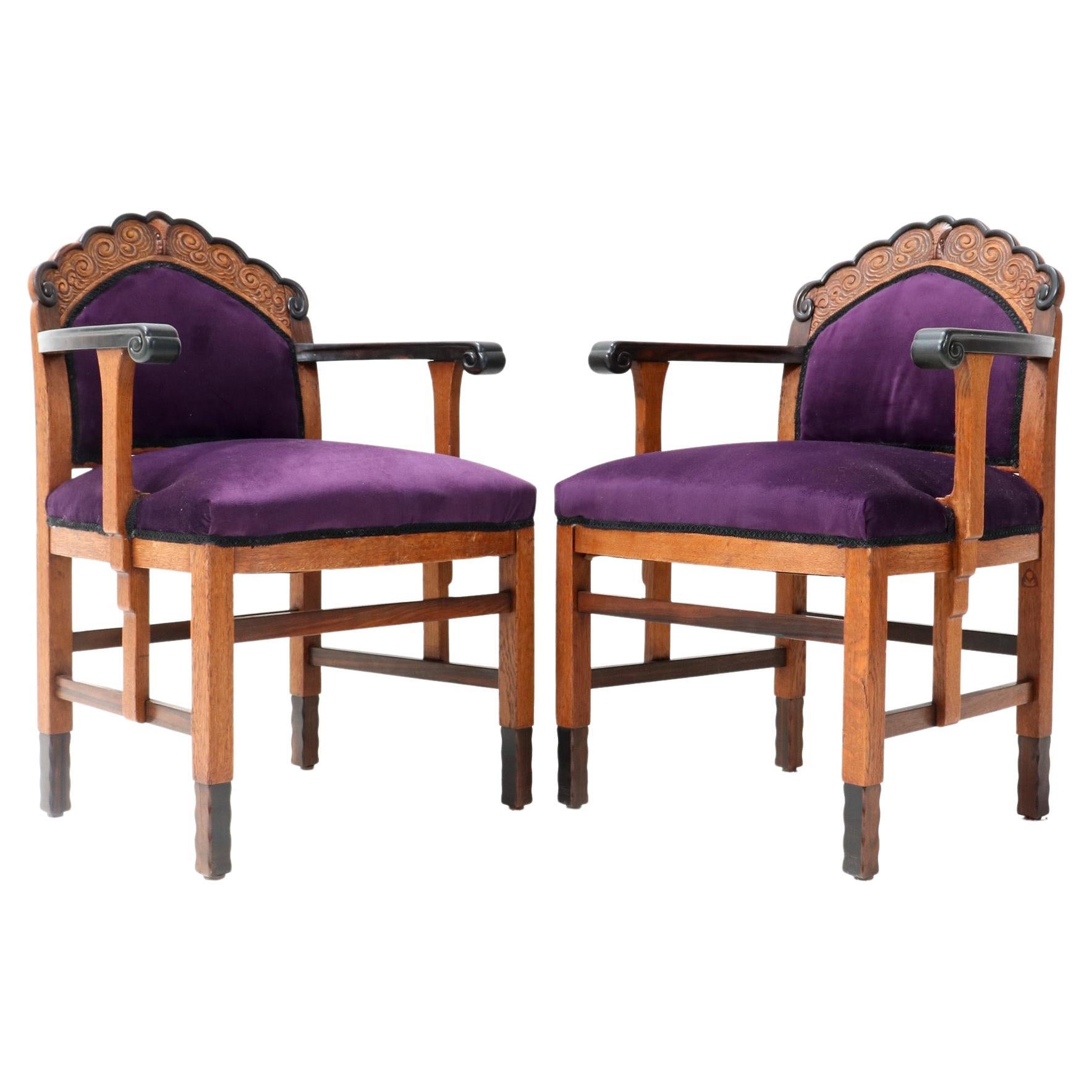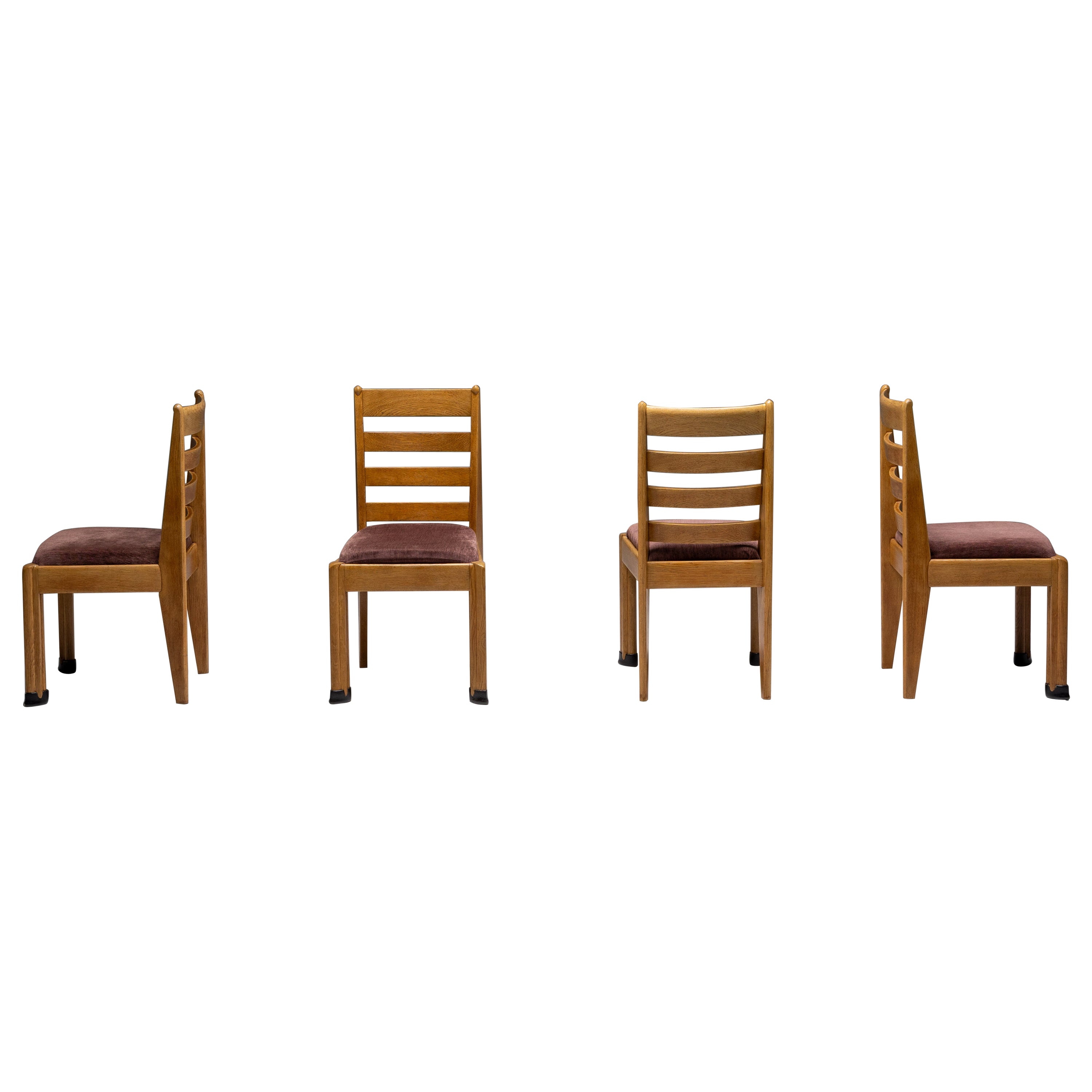Items Similar to Dutch Art Deco Haagse School rationalist desk chair, 1920s
Want more images or videos?
Request additional images or videos from the seller
1 of 16
Dutch Art Deco Haagse School rationalist desk chair, 1920s
About the Item
A 1920s Dutch Haagse School desk chair in solid oak and with the original seat (springs inside), upholstered in leatherette. The chair has a low backrest which gives it a cubist and modernist appearance. With its modest size and height it is also very suitable as a side chair for styling.
The shape of the chairs' legs and back remind of designs by architect Muntendam for L.O.V. Oosterbeek.
The seat widens from back to front (50 to 60 cm) Seat height is around 52 cm. Total height is 80 cm.
The chair is in very good condition, stable and sturdy.
In the 1920s, a style of architecture and furniture design emerged in The Hague that would become known as The Hague School. More sober than the imaginative Amsterdam School and more elegant and luxurious than De Stijl, this style is also referred to as Dutch Art Deco.
After the First World War, young designers such as Henk Wouda, Cor Alons and J. Brunott developed their own modern design for the interior. They were inspired by the modernist work of the American architect Frank Lloyd Wright. The result was the now well-known Dutch 'Hague School' style with its straight and cubist shapes.
- Similar to:J.A. Muntendam (Designer)
- Dimensions:Height: 31.5 in (80 cm)Width: 23.63 in (60 cm)Depth: 18.9 in (48 cm)Seat Height: 20.48 in (52 cm)
- Style:Art Deco (Of the Period)
- Materials and Techniques:
- Place of Origin:
- Period:
- Date of Manufacture:c. 1920
- Condition:
- Seller Location:EVERDINGEN, NL
- Reference Number:1stDibs: LU8096239512162
About the Seller
5.0
Gold Seller
These expertly vetted sellers are highly rated and consistently exceed customer expectations.
Established in 2023
1stDibs seller since 2023
13 sales on 1stDibs
Typical response time: <1 hour
- ShippingRetrieving quote...Ships From: EVERDINGEN, Netherlands
- Return PolicyA return for this item may be initiated within 7 days of delivery.
More From This SellerView All
- Dutch Art Deco Haagse School Armchair, 1920sBy Frits SpanjaardLocated in EVERDINGEN, NLAn antique architectural Dutch armchair in solid oak and an extraordinary design. The chair has a robust look and is heavy in weight. Still it has a modest size and height and is be ...Category
Vintage 1920s Dutch Art Deco Armchairs
MaterialsOak
- Dutch Art Deco Modernist Haagse School pedestal, 1920sBy Genneper Molen, P.E.L. Izeren 1Located in EVERDINGEN, NLDutch Haagse School 1920s plinth, pedestal or candle stand attributed to designer P.E.L. Izeren for ''De Genneper Molen''. This piece was most probably designed as an altar candle h...Category
Vintage 1920s Dutch Art Deco Pedestals and Columns
MaterialsOak, Macassar
- Dutch Art Deco Umbrella Stand, Haagse School, 1920sLocated in EVERDINGEN, NLA large Haagse School 1920s umbrella stand with a geometric, modernist design. The stand is solid oak with subtle decorations and stretchers in macassar ebony. Symmetric and very sty...Category
Vintage 1920s Dutch Art Deco Umbrella Stands
MaterialsMacassar, Oak
- Dutch Art Deco De Stijl/Haagse School set of chairs, 1920sLocated in EVERDINGEN, NLUnique set of four early (around 1910-1920) Haagse School dining chairs with De Stijl influences. Very austere and functional design with clean lines and oval shaped recesses that op...Category
Vintage 1920s Dutch Art Deco Side Chairs
MaterialsOak, Leather
- Haagse School Dutch Art Deco side or serving table by Wouda for Pander, 1920sBy Pander, Hendrik WoudaLocated in EVERDINGEN, NLA side table or serving table, designed by Hendrik Wouda and manufactured by Pander & Sons, 1920s (marked with metal plate under front drawer). The modernist design with the pointed...Category
Vintage 1920s Dutch Art Deco Card Tables and Tea Tables
MaterialsOak, Macassar
- Dutch Art Deco Amsterdam School floor lamp, 1920sLocated in EVERDINGEN, NLAn elegant Dutch Art Deco 1920s floorlamp, Amsterdamse School (Amsterdam School). Made from solid woodcarved oak, 4 padouk leg ends and decorated with slats of macassar, this piece h...Category
Vintage 1920s Dutch Art Deco Floor Lamps
MaterialsMacassar, Padouk, Oak
You May Also Like
- Two Oak Art Deco Amsterdamse School Armchairs, 1920sLocated in Amsterdam, NLMagnificent and ultra rare set of two Art Deco Amsterdamse School armchairs. Design by unknown artist but in the manner of the Fa. Drilling Amsterdam. Striking ...Category
Vintage 1920s Dutch Art Deco Armchairs
MaterialsOak, Velvet, Macassar
- Two Oak Art Deco Amsterdamse School Armchairs, 1920sLocated in Amsterdam, NLStunning and rare pair of Art Deco Amsterdamse School armchairs. Striking Dutch design from the 1920s. Solid oak frames with macassar ebony veneered backs. The seats are upholster...Category
Vintage 1920s Dutch Art Deco Armchairs
MaterialsMacassar, Oak, Fabric
- Dutch Art Deco oak and leather armchair, 1920sLocated in Delft, NLDutch Art Deco oak and leather armchair, 1920s An oak and brown leather armchair from the Art Deco period, 1920s, The Netherlands. The wood has a beautiful handcut wooden pattern of...Category
Early 20th Century Dutch Armchairs
MaterialsLeather, Oak
- Rationalist Dining Chairs in Oak, Holland, 1920sLocated in Antwerp, BEOak dining chairs, Dutch Art Deco era, Hague school, 1928. Minimalist and modern for its time. Truly an Avant-Garde item. Certainly an inspiration for later Scandinavian Modern desig...Category
Vintage 1920s Dutch Modern Dining Room Sets
MaterialsOak
- Art Deco Haagse School Armchair Hendrik Wouda Set of 2By Hendrik WoudaLocated in Bjuråker, SE2 oak Art Deco armchairs from the 1920s. Designed and made during the Haagse School period, probably Hendrik Wouda. The heavy and sturdy chairs are in very good condition. The imitat...Category
Vintage 1920s Dutch Art Deco Armchairs
MaterialsFaux Leather, Oak
- Desk Chair Style: Art Deco, France, 1920Located in Ciudad Autónoma Buenos Aires, CArt Deco desk chair Country: France If you are looking for a desk chair to match your desk, we have what you need. We have specialized in the sale of Art Deco and Art Nouveau and Vintage styles since 1982. If you have any questions we are at your disposal. Pushing the button that reads 'View All From Seller'. And you can see more objects to the style for sale. Why are there so many antiques in Argentina? In the 1880 – 1940 there was a grate wave of immigration encouraged by the periods of war that were taking place. 1st World War took place between 1914 and 1918 2nd World War took place between 1939 and 1945 The immigrants options were New York or Buenos Aires. Tickets were cheap and in Buenos Aires they were welcomed with open arms, as it was a country where everything was still to be done. Argentina was the country of new opportunities, labour was needed and religious freedom was assured, in many cases the of the family travel first until they were settled and then the rest of the family members join them. In the immigrant museum “Ellis Island Immigrant Building” in New York you can se the promotional posters of the boats that would take them to a new life. Between the years 1895 and 1896, Argentina had the highest DGP (gross domestic product) per capita in the world according to the Maddison Historical Statistics index, this situation arose due to the large amount of food being exported to European countries, which were at war. The Argentinean ships left the port of Buenos Aires with food, but they returned with furniture, clothes and construction elements, (it´s common to see this the old buildings of the historic neighbourhood of San Telmo, the beams with the inscription “Made in England)”, as well as many markets that were built in Buenos Aires, such us the San Telmo Market, whose structure was brought by ship and afterwards assembled in 900 Defensa Street. With the great influence of European immigrants living in the country, the children of the upper classes travelled to study in France, resulting in the inauguration of “La Maison Argentinienne”, on 27th of June 1928, in the international city of Paris, which hosted many Argentinians that were studying in Frace. It´s the fourth house to be built after France, Canada and Belgium, being the first Spanish-speaking one. Still in place today (17 Bd Jourdan, 75014, Paris, France). Many of the children of these wealthy families who attended international art exhibitions, museums and art courses abroad, took a keen interest in the European style. This is why Buenos Aires was at the time referred as “The Paris of South America”. Between the years 1890 and 1920 more than a hundred Palaces were built on Alvear Avenue the most exclusive avenue in Buenos Aires. Today some of these palaces have been transformed into museums, hotels and embassies. In the year 1936, the Kavanagh building was inaugurated, it was the tallest reinforced concrete building in South America. During 1994 the American Society of Civil Engineers distinguished it as an “international engineering milestone”, and it´s now considered a World Heritage of Modern Architecture. At the time was common to hire foreign architects such as Le Corbusier, who visited Buenos Aires/Argentina in 1929 and in 1948 he drew up the blueprints for a house built in La Plata City (which was declared a World Heritage Site). In 1947, the Hungarian architect Marcelo Breuer designed “Parador Ariston” in the seaside city of Mar del Plata. After an Argentinean student at Harvard University convinced him to come to Argentina. He worked on an urban development project in the Casa Amarilla, area of La Boca. The Ukrainian architect, Vladimiro Acosta, arrives in Argentina in 1928 and worked as an architect until que moved to Brazil. Antonio Bonet, a Spanish architect who worked with Le Corbusier in Paris, arrives in Argentina in 1937, where he carried out several architectural works and in 1938 designs the well-known BFK...Category
Vintage 1920s French Art Deco Office Chairs and Desk Chairs
MaterialsWood
Recently Viewed
View AllMore Ways To Browse
Dutch School Furniture
Holland Art Deco
School Desks Used
Used School Desk
Original Frank Lloyd Wright Furniture
Dutch Modernist
V Leg Furniture
Antique School Chair Chairs
Antique School Chair
Antique School Chairs
American School Chair
Dutch Furniture Modernist
Frank Lloyd Wright Furniture Style
Frank Lloyd Wright Style Furniture
Art Deco Amsterdam School
Dutch Design Desk
Antique Architectural Desk
Amsterdam School Oak





